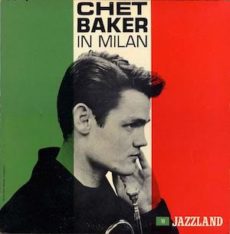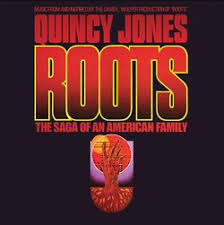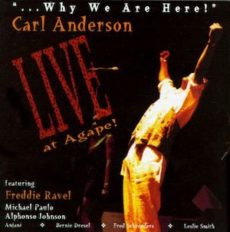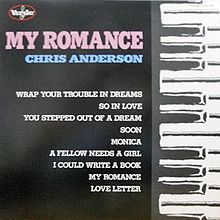
Requisites
Chet Baker In Milan ~ Chet Baker | By Eddie Carter
The year 1959 was very good for jazz, several albums recorded and released that year would become contemporary classics and a significant few, acknowledged masterpieces. It was also a good year for Chet Baker, three LP’s he recorded are considered among his best, Chet, Chet Baker Plays The Best of Lerner & Lowe, and this morning’s choice from the library, Chet Baker In Milan (Jazzland JLP-18/JLP 918S). On this date, the trumpet player made during an extended tour through Germany and France, Chet’s working with five promising Italian musicians, Glauco Masetti on alto sax, Gianno Basso on tenor sax (tracks: A1 to A4, B1, B2), Renato Sellani on piano, Franco Cerri (listed as Serri) on bass, and Gene Victory on drums. My copy used in this report is the 1989 Original Jazz Classics Mono reissue (Jazzland OJC-370).
The opener, Lady Bird was written in 1939 by Tadd Dameron, and the sextet starts with a feisty theme statement. Chet opens with a vibrantly energetic reading set to an almost danceable beat, then Gianno follows with an enthusiastic improvisation. Glauco accentuates the bluesy momentum with a very enjoyable statement. Renato shows off his startling speed on the closer before the front line gives a few final verses.
Cheryl Blues by Charlie Parker was composed in 1947 and originally titled Cheryl. The sextet introduces the relaxing melody collectively. Baker is up first and makes the lead statement extremely interesting, then Basso gives the next spot a meaty interpretation. Masetti is as cool as a fresh breeze on a hot day next, and Sellani executes a fine touch and a steady hand to the finale.
The ensemble moves back into uptempo territory on Tune-Up by Miles Davis. It was written in 1953 and made its debut on the album, Miles Davis Quartet (1954). The sextet begins the melody with a swift-paced delivery, then Chet takes off first with astounding energy. Glauco follows with a feisty attack, and Gianno swings fiercely on the third solo. Renato provides a sparkling climax ahead of the front line’s final exchange into the ending.
Line For Lyons by Sonny Rollins begins with the unison theme at a medium tempo. Baker makes the first move with a cool tone, and Basso gives the second reading a pleasing rhythm. Masetti expresses himself fluently on the next interpretation. Sellani turns in a very attractive presentation next and Serri takes his first solo opportunity with a noteworthy closing statement.
Pent-Up House by Sonny Rollins starts Side Two and was first heard on the album, Sonny Rollins Plus 4 (1956). The sextet begins the opening chorus jointly. Chet sets the groove with a spirited statement, then Gianno solos confidently next. Glauco follows with a bristling interpretation. Renato provides a short, pithy presentation, then the front line shares a brief exchange leading to a soft climax.
The ensemble takes a page from The Great American Songbook for the 1919 song, Look For The Silver Lining by Jerome Kern and Buddy DeSylva. This tune was featured in two musicals, Zip, Goes A Million, that year, and Sally, a year later. The ensemble opens this oldie, but goodie with a finger-snapping mid-tempo theme. Baker, Masetti, Basso, and Sellani deliver four lively statements ahead of the reprise.
The 1919 song, Indian Summer was written by Victor Herbert who composed it originally as an instrumental piano piece. It became a jazz standard in 1939 after Al Dubin added the lyrics. For this song, Baker’s trumpet is marvelously lyrical with an amorous romantic beauty in his sound. This is particularly noticeable in the opening statement by Baker and a closing performance by Sellani that’s lavishly flavored with exceptional phrasing.
The album wraps up with the 1934 ballad, My Old Flame by Sam Coslow and Arthur Johnston. It opens with a gorgeous introduction and tender melody by Baker who almost seems to identify with the love, loss, and heartbreak of the lyrics in his opening statement and closing chorus. Sellani also gives a memorable account that’s brief, but beautifully nuanced and matched by Serri and Victory who support both soloists in perfect harmony.
Alto saxophonist Glauco Masetti was classically trained on violin and attended the Milan and Turin conservatories. He was self-taught on reed instruments and worked often as a session musician from the forties to the sixties. He also worked with Gianni Basso, Gil Cuppini, Giorgio Gaslini, Oscar Valdambrini, and Eraldo Volonté among others. Tenor man Gianni Basso was a renowned Italian saxophonist whose influence was Stan Getz. His career began after World War II as a clarinetist, before switching to the saxophone in The Belgian Raoul Falsan’s Big Band. Pianist Renato Sellani was also a composer who began his career as a professional in 1954 as a member of The Gianni Basso-Oscar Valdambrini Quintet. In 1958, he began a lengthy collaboration with his friend, guitarist, and bassist, Franco Cerri who turned ninety-five this past January. He was also a member of The RAI National Symphony Orchestra under the direction of Gorni Kramer, Kramer was also a noted musician and songwriter. He’s also worked with Bill Coleman and Dizzy Gillespie, Billie Holiday, Lee Konitz, Gerry Mulligan, Enrico Rava, and Tony Scott.
Double bassist Franco Cerri is considered one of Europe’s most important musicians and learned to play guitar when he was seventeen years old. His influences were guitarists Barney Kessel, René Thomas, and Django Reinhardt. In 1945, he became a member of the group led by Gorni Kramer and joined the orchestra of the television show, Buone Vacanze (Happy Holidays). He started playing the double bass in addition to guitar in the fifties and has played with Lou Bennett, Buddy Collette, Stéphane Grappelli, Johnny Griffin, Lars Gullin, Billie Holiday, Lee Konitz, Gerry Mulligan, Django Reinhardt, Tony Scott, Bud Shank, and The Modern Jazz Quintet. Giulio Libano who wrote the arrangements for the sextet was also an orchestra leader, jazz pianist, and trumpet player. He composed two songs that are featured in the 1961 Italian films, Girl With a Suitcase and Io Bacio…Tu Baci (Io Bacio…You Kiss)! Sadly, the only person I was unable to find any information on is drummer Gene Victory.
The description on the back cover giving the date of the entire recording as October 1959 is in error. Lady Bird was recorded on September 25, Cheryl Blues, Tune-Up, and Line For Lyons on September 26. Pent-Up House, Look For The Silver Lining, Indian Summer, and My Old Flame on October 6. I can’t provide the name of the engineer who originally recorded the album, but I can say with certainty it’s a superb recording that received excellent remastering by Phil De Lancie of Fantasy Studios. Baker is in excellent form throughout, the ensemble is watertight, and the level of soloing extremely high. If you’re a fan of Chet Baker and Cool Jazz, I highly recommend this album for a spot in your library. If you’ve read this far and are still uncertain, I’ll leave you with the first line of this report. The year 1959 was very good for jazz, Chet Baker In Milan, is one of the reasons why!
~ Chet (Riverside RLP 12-299/RLP-1135), Chet Baker Plays The Best of Lerner & Lowe (Riverside RLP 12-307/RLP 1152), Miles Davis Quartet (Prestige PRLP-161), Sonny Rollins Plus 4 (Prestige PRLP-7038/PRST-7291) – Source: Discogs.com ~ Girl With a Suitcase and Io Bacio…Tu Baci (Io Bacio…You Kiss) – Source: IMDB.com ~ Look For The Silver Lining, Indian Summer, Glauco Masetti, Gianni Basso, Renato Sellani, Franco Cerri, Giulio Libano – Source: Wikipedia.org ~ Lady Bird – https://www.youtube.com/watch?v=Vwio99V8-cw ~ Cheryl Blues – http://www.youtube.com/watch?v=AfbUraDG-mU © 2021 by Edward Thomas Carter
More Posts: choice,classic,collectible,collector,history,instrumental,jazz,music,trumpet

Daily Dose Of Jazz…
William Earnest Green was born on February 28, 1925 in Kansas City, Kansas and learned to play the alto saxophone at age ten, picking up the clarinet when he was twelve. He eventually learned to play most varieties of saxophone, clarinet, and flute.
Serving in the military until 1946, Green began working at a club called Small’s in Kansas City. Relocating to Los Angeles, California in 1947 he enrolled at the Los Angeles Conservatory of Music and Arts, and graduating in 1952 remained on staff as an educator until 1962. He also ran a music education studio on La Brea Avenue in Los Angeles for many years.
During his early career Bill played with Gerald Wilson, and began working with Benny Carter in the latter half of the 1950s. From 1959 to 1962 he played in Louie Bellson’s big band, then went to work extensively as a section player in the bands of Quincy Jones, Henry Mancini, and Buddy Rich. He would accompany vocalists such as Frank Sinatra, Tony Bennett, Nat King Cole, Nancy Wilson, and Dionne Warwick.
Through the mid to late Sixties he played the Monterey Jazz Festival with Gil Fuller, worked with Oliver Nelson, and then Blue Mitchell. The 1970s saw him performing or recording with Gene Ammons, the Capp-Pierce Juggernaut, Ella Fitzgerald, Sonny Rollins, and Sarah Vaughan. He continued working with the Capp-Pierce Orchestra in the early 1980s, as well as with Lionel Hampton, Woody Herman, and the Clayton-Hamilton Jazz Orchestra.
His most notable recordings are Benny Carter’s Aspects and the Quincy Jones recording of the soundtrack for Roots. Multi-instrumentalist Bill Green, who played most saxophones, clarinet and flute, passed away on July 29, 1996. His personal papers and recordings are archived at University of California, Los Angeles..
More Posts: clarinet,flute,history,instrumental,jazz,music,saxophone

Daily Dose Of Jazz…
Carl Anderson was born Carlton Earl Anderson on February 27, 1945 in Lynchburg, Virginia, one of 12 children to James and Alberta Anderson. During his junior year of high school, he enlisted in the U.S. Air Force, where he served as a communications technician for two years. Honorably discharged and returning home he completed high school, graduating in 1965. He went on to sing at military bases across the United States as part of the World Wide Air Force Talent Contest.
Making his way to Washington, D.C. in 1969, he and some friends formed a group called The Second Eagle with Anderson handling the vocals. They covered jazz and rock tunes that included songs from the album Jesus Christ Superstar, released long before the stage production was launched. In 1971, a talent agent from the William Morris Agency saw Anderson perform some songs from the show at St. Stephen’s Church and recognized his potential as a solo performer.
His global popularity and star power came from his role as Judas in Jesus Christ Superstar both on Broadway and in the film. He also had rolesin The Black Pearl, The Color Purple, The Eddie Capra Mysteries, Cop Rock, Days of Our Lives, and Hill Street Blues.
As a recording artist, Carl was equally prolific, initially signing with Motown Records in 1972, working with Stevie Wonder on his Songs in the Key of Life double album, as well as numerous others. While working the club circuit in Los Angeles, California he was noticed by and signed to Columbia Records and released four albums on their Epic label. He would go on to perform duets with Gloria Loring, Angie Bofill, Linda Eder and Nancy Wilson.
His duet with Loring, Friends and Lovers, reached Number 2 on the charts, and endeared Anderson to soap opera fans, after being performed on Days of Our Lives. He also recorded Between You and Me, as the title theme for the film Her Alibi.
In 2003 he had a minor car accident on his way to perform and while being treated for his injuries, doctors discovered that he had leukemia. Soul jazz vocalist and actor Carl Anderson passed away the following year from the illness on February 23, 2004, in Los Angeles, just four days before his 59th birthday.

Daily Dose Of Jazz…
Chris Anderson was born on February 26, 1926 in Chicago, Illinois and self-taught, began playing in Chicago clubs in the mid-1940s and played with Von Freeman and Charlie Parker, among others. Hired as Dinah Washington’s accompanist, his tenure with her was brief, as Washington changed accompanists frequently. She fired him in New York six weeks after hiring him, but he chose to remain in the city.
In 1960 he recorded what might be his best regarded album My Romance on the VeeJay label with bassist Bill Lee and drummer Art Taylor. Despite the respect of his peers, Anderson had difficulty finding work or popular acclaim due in large part to his disabilities. He was blind and his bones were unusually fragile, causing numerous fractures, which at times compromised his ability to perform at the times or places requested.
He continued to record until he was well into his 70s. A DownBeat profile indicated he had Osteogenesis, probably meaning osteogenesis imperfecta.
Pianist Chris Anderson, who was best known for his influence on his student Herbie Hancock, passed away of a stroke on February 4, 2008 in Manhattan, New York. He was 81.
More Posts: bandleader,history,instrumental,jazz,music,piano

Conversations About Jazz & Other Distractions
Conversations About Jazz Presents
Rubin & Dameron: A Perfect Match on February 25
On Thursday, February 25 at 7:30 pm (EST) Hammonds House Digital invites you to join us for Conversations About Jazz & Other Distractions with host Carl Anthony. Carl’s special guest will be jazz vocalist Vanessa Rubin and they will discuss her career, sample some of her favorite songs, and delve into her latest CD, This Dream is You: Vanessa Rubin Sings Tadd Dameron. This free virtual program will stream on Hammonds House Museum’s Facebook and YouTube channels. For more information about this and upcoming virtual events visit hammondshouse.org.
Revered as both a torchbearer and a storyteller, jazz vocalist Vanessa Rubin possesses a voice hailed for crystalline clarity, warmth, and playful sass. The Cleveland native brings a wealth of diverse influences to her vocal performance from both the Trinidadian/Caribbean roots of her mother and traditional jazz by way of her Louisiana-born father. Additional influences include the melodic bell tone clarity of a young Nancy Wilson, the fire of Lambert, Hendricks & Ross, the sweet sounds of trumpeter Blue Mitchell, and her love of the Motown Sound…especially girl groups like the Supremes.
Rubin’s passion for rich musical stories is evident throughout her eight albums. Highlights include the evocative “Voyager II” from the pen of Teri Thornton, “Inside a Silent Tear” written by Blossom Dearie, a waltz version of John Coltrane’s “Giant Steps” lyricized by New York Voices, and an arrangement of “Superwoman” by Stevie Wonder, inspired by the Ahmad Jamal recording of “Poinciana.” Her current endeavors include highlighting and interpreting well known, obscure and new lyrical works of composer/arranger/pianist Tadd Dameron. “I hope to do for Tadd’s music what Carmen McRae did for Monk’s music,” Rubin explained. For more information visit: vanessarubin.com.
Tadd Dameron (1917-1965) was American jazz pianist, arranger, composer, and bandleader. The most influential arranger of the bebop era, he also wrote charts for swing and hard bop players. The bands he arranged for included those of Count Basie, Artie Shaw, Jimmie Lunceford, Dizzy Gillespie, Billy Eckstine, and Sarah Vaughan. In 1940-41 he was the piano player and arranger for the Kansas City band Harlan Leonard and his Rockets. He and lyricist Carl Sigman wrote “If You Could See Me Now” in 1946 for Sarah Vaughan and it became one of her first signature songs. Dameron wrote many arrangements for Gillespie’s big band, who gave the première of his large-scale orchestral piece Soulphony in Three Hearts at Carnegie Hall in 1948. Later in 1948, Dameron led his own group in New York, which included Fats Navarro. The following year Dameron performed at the Paris Jazz Festival with Miles Davis.
Hammonds House Museum is generously supported by the Fulton County Board of Commissioners, Fulton County Arts and Culture, the City of Atlanta Mayor’s Office of Cultural Affairs, The Community Foundation for Greater Atlanta, The National Performance Network, AT&T and WarnerMedia.
Hammonds House Museum’s mission is to celebrate and share the cultural diversity and important legacy of artists of African descent. The museum is the former residence of the late Dr. Otis Thrash Hammonds, a prominent Atlanta physician and a passionate arts patron. A 501(c)3 organization which opened in 1988, Hammonds House Museum boasts a permanent collection of more than 450 works including art by Romare Bearden, Robert S. Duncanson, Benny Andrews, Elizabeth Catlett, Jacob Lawrence, Hale Woodruff, Amalia Amaki, Radcliffe Bailey and Kojo Griffin. In addition to featuring art from their collection, the museum offers new exhibitions, artist talks, workshops, concerts, poetry readings, arts education programs, and other cultural events throughout the year.
Located in a beautiful Victorian home in Atlanta’s historic West End, Hammonds House Museum is a cultural treasure and a unique venue. During the COVID-19 pandemic, they continue to observe CDC guidelines, but look forward to welcoming in-person visitors soon! For more information about upcoming virtual events, and to see how you can support their mission and programming, visit their website: hammondshouse.org.
More Posts: arranger,composer,conversations,history,instrumental,jazz,musicians,piano,vocal



